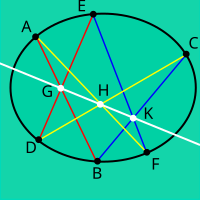Pascal's theorem

Okay kiddo, do you know what a hexagon is? It's a shape that has six sides, right? Well, Pascal's theorem is about what happens when you draw a circle around a hexagon.
Let's imagine we have a hexagon and we draw a circle around it. Then we draw lines connecting each of the six corners of the hexagon to form a new shape - a hexagon inside the circle.
Now here comes the really cool part. If we choose any three points on the hexagon (that means we select three of the corners), and draw lines connecting them, then those lines will all meet at the same point on the circle.
It's like magic! It works for any three points you choose.
Pascal's theorem is a special rule or formula that tells us why this happens. It's named after a smart man named Blaise Pascal who figured it out a long, long time ago.
Basically, the theorem says that if you take any hexagon that can be drawn inside a circle, and then select any three non-collinear points (which means they're not on a straight line), and then connect them in pairs to form three pairs of lines, then those pairs of lines will always meet at three points that lie on a straight line.
So, in our example, even though we only see one point of intersection, the two other points are really just off the edge of the circle.
It might all sound a bit complicated, but it's actually pretty amazing that it always works out this way!
Let's imagine we have a hexagon and we draw a circle around it. Then we draw lines connecting each of the six corners of the hexagon to form a new shape - a hexagon inside the circle.
Now here comes the really cool part. If we choose any three points on the hexagon (that means we select three of the corners), and draw lines connecting them, then those lines will all meet at the same point on the circle.
It's like magic! It works for any three points you choose.
Pascal's theorem is a special rule or formula that tells us why this happens. It's named after a smart man named Blaise Pascal who figured it out a long, long time ago.
Basically, the theorem says that if you take any hexagon that can be drawn inside a circle, and then select any three non-collinear points (which means they're not on a straight line), and then connect them in pairs to form three pairs of lines, then those pairs of lines will always meet at three points that lie on a straight line.
So, in our example, even though we only see one point of intersection, the two other points are really just off the edge of the circle.
It might all sound a bit complicated, but it's actually pretty amazing that it always works out this way!
Related topics others have asked about:
